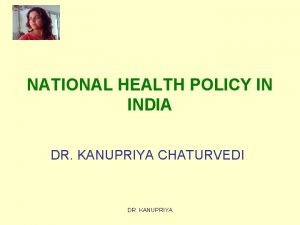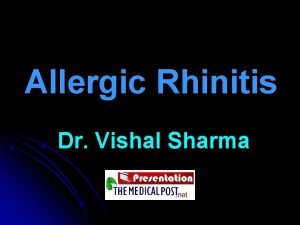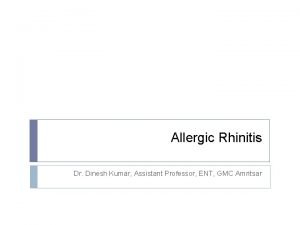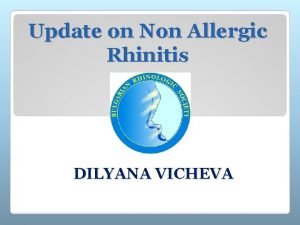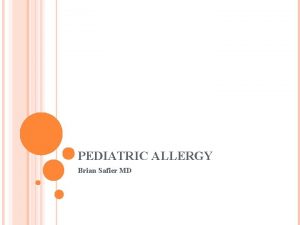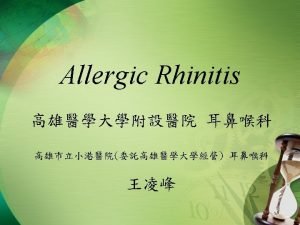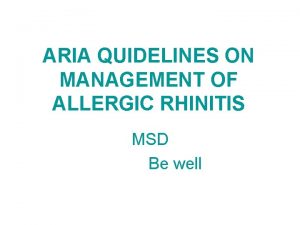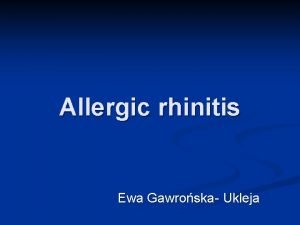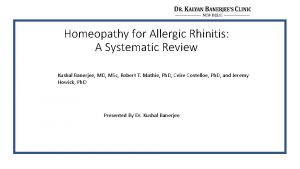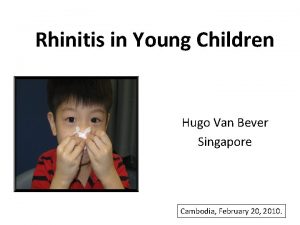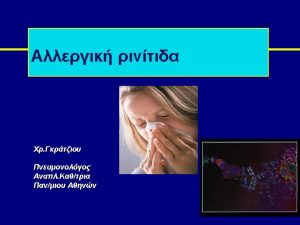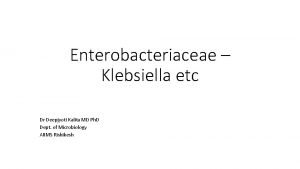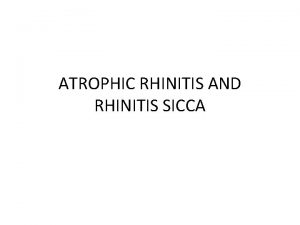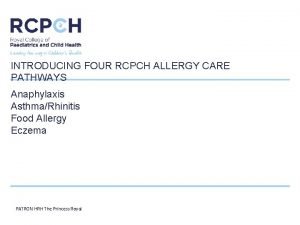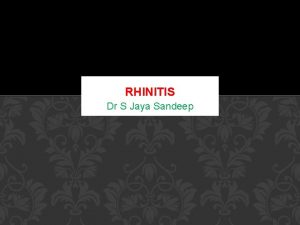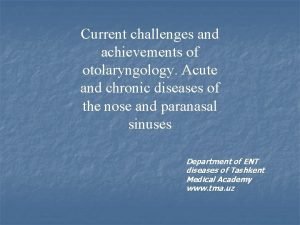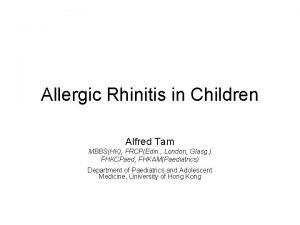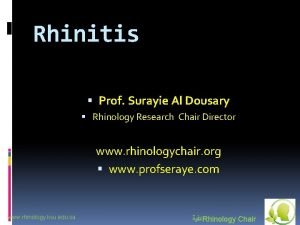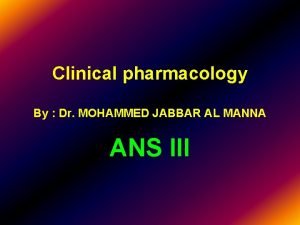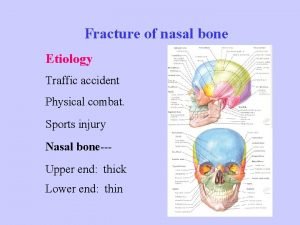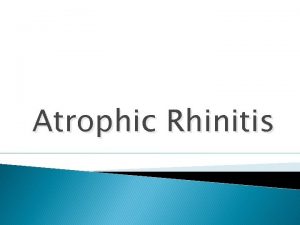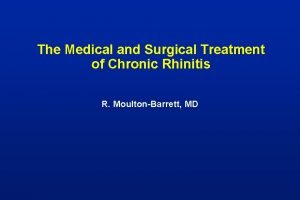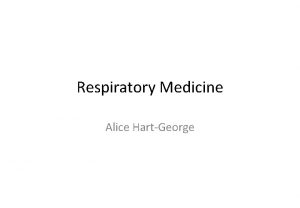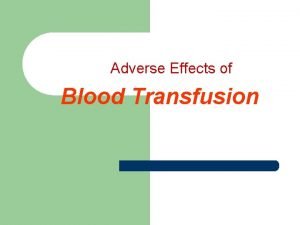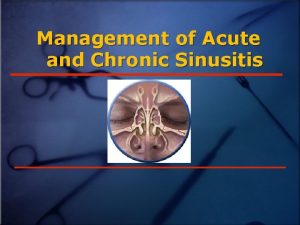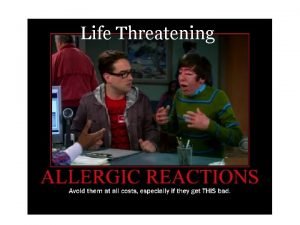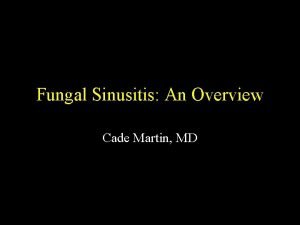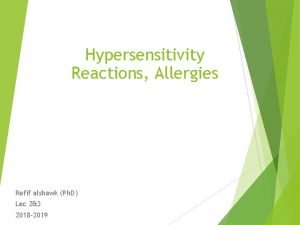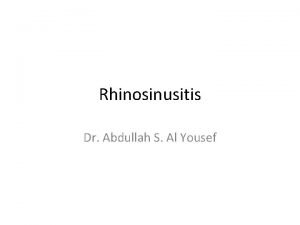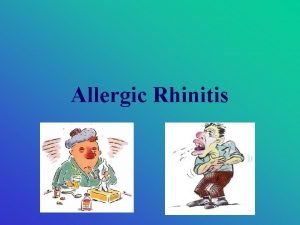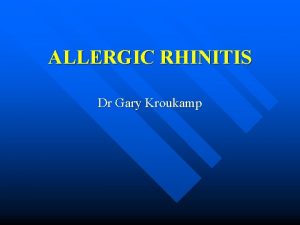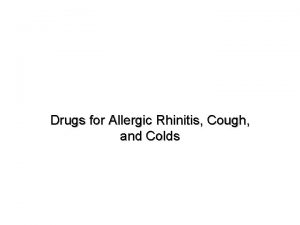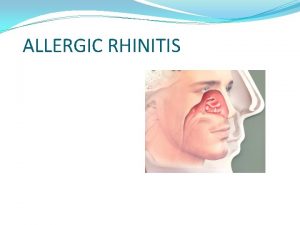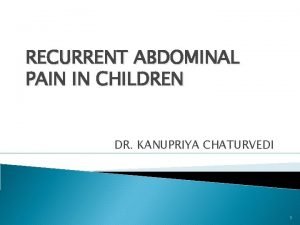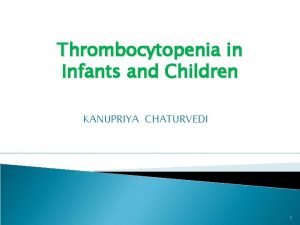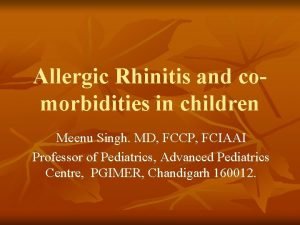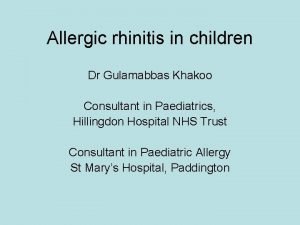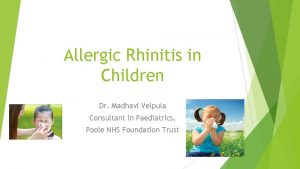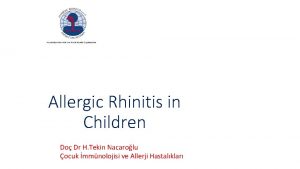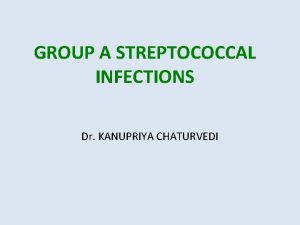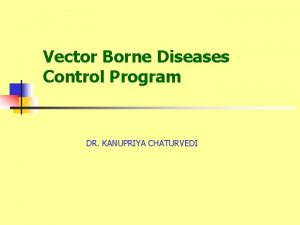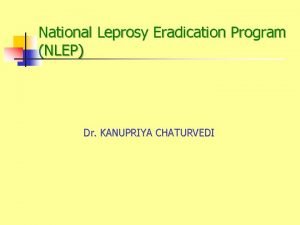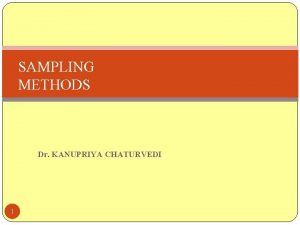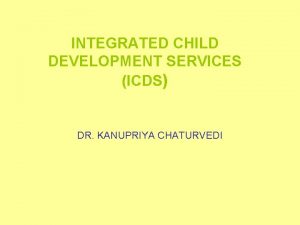Allergic Rhinitis in Children Dr KANUPRIYA CHATURVEDI Outline













































- Slides: 45

Allergic Rhinitis in Children Dr. KANUPRIYA CHATURVEDI

Outline of Presentation • • What is allergic rhinitis? Epidemiology Pathophysiology Diagnosis and differential diagnosis Assessment and classification of AR Health effects of AR Management of AR

What is Allergic Rhinitis • Allergic rhinitis involves inflammation of the mucous membranes of the nose, eyes, eustachian tubes, middle ear, sinuses, and pharynx. • The nose invariably is involved, and the other organs are affected in certain individuals. • Inflammation of the mucous membranes is characterized by a complex interaction of inflammatory mediators but ultimately is triggered by an immunoglobulin E (Ig. E)– mediated response to an extrinsic protein

• • • Rhinorhoea Nasal blockage Postnasal drip Itchiness Sneezing Associated health effects ‼ Ig. E mediated

Pathophysiology • The tendency to develop allergic, or Ig. E-mediated, reactions to extrinsic allergens has a genetic component. • In susceptible individuals, exposure to certain foreign proteins leads to allergic sensitization, which is characterized by the production of specific Ig. E directed against these proteins. • This specific Ig. E coats the surface of mast cells, which are present in the nasal mucosa. • When the specific protein is inhaled into the nose, it can bind to the Ig. E on the mast cells, leading to immediate and delayed release of a number of mediators.

Pathophysiology • The mediators that are immediately released include histamine, tryptase, chymase, kinins, and heparin. • The mast cells quickly synthesize other mediators, including leukotrienes and prostaglandin D 2. • These mediators, via various interactions, ultimately lead to the symptoms of rhinorrhea (ie, nasal congestion, sneezing, itching, redness, tearing, swelling, ear pressure, postnasal drip). • Mucous glands are stimulated, leading to increased secretions. Vascular permeability is increased, leading to plasma exudation. • Vasodilation occurs, leading to congestion and pressure. Sensory nerves are stimulated, leading to sneezing and itching. All of these events can occur in minutes; hence, this reaction is called the early, or immediate, phase of the reaction

Pathophysiology • Over 4 -8 hours, these mediators, through a complex interplay of events, lead to the recruitment of other inflammatory cells to the mucosa, such as neutrophils, eosinophils, lymphocytes, and macrophages. • This results in continued inflammation, termed the latephase response. • The symptoms of the late-phase response are similar to those of the early phase, but less sneezing and itching and more congestion and mucus production tend to occur. [13] • The late phase may persist for hours or days.

Epidemiology Frequency: Allergic rhinitis affects approximately 40 million people in the United States. Recent US figures suggest a 20% cumulative prevalence rate. Scandinavian studies have demonstrated a cumulative prevalence rate of 15% in men and 14% in women. [17] The prevalence of allergic rhinitis may vary within and among countries. This may be due to geographic differences in the types and potency of different allergens and the overall aeroallergen burden. Mortality/Morbidity- While allergic rhinitis itself is not life-threatening (unless accompanied by severe asthma or anaphylaxis), morbidity from the condition can be significant. Allergic rhinitis often coexists with other disorders, such as asthma, and may be associated with asthma exacerbations.

Epidemiology Race: Allergic rhinitis occurs in persons of all races. Prevalence of allergic rhinitis seems to vary among different populations and cultures, which may be due to genetic differences, geographic factors or environmental differences, or other population-based factors. Sex: In childhood, allergic rhinitis is more common in boys than in girls, but in adulthood, the prevalence is approximately equal between men and women. Age: Onset of allergic rhinitis is common in childhood, adolescence, and early adult years, with a mean age of onset 8 -11 years, but allergic rhinitis may occur in persons of any age. In 80% of cases, allergic rhinitis develops by age 20 years.

Diagnosis of Allergic Rhinitis 1. History & symptoms of recurrent or persistent rhinitis and/or associated health effects 2. Signs of atopy and recurrent or persistent rhinitis 3. Demonstration of Ig. E allergy 4. Exclusion of other causes of rhinitis

Diagnosis of Allergic Rhinitis 1. History & clinical symptoms of recurrent or persistent rhinitis and/or associated health effects – – – Rhinorhoea Nasal blockage Postnasal drip Itchiness Sneezing Others: conjunctivitis, eczema, asthma, chronic rhinosinusitis, otitis media with effusion, sleep obstruction…

History Important elements in history include an evaluation of the nature, duration, and time course of symptoms; possible triggers for symptoms; response to medications; comorbid conditions; family history of allergic diseases; environmental exposures; occupational exposures; and effects on quality of life. • Symptoms that can be associated with allergic rhinitis include sneezing, itching (of nose, eyes, ears, palate), rhinorrhea, postnasal drip, congestion, headache, earache, tearing, red eyes, eye swelling, fatigue, drowsiness, and malaise.

Symptoms and chronicity • Determine the age of onset of symptoms and whether symptoms have been present continuously since onset. • Determine the time pattern of symptoms and whether symptoms occur at a consistent level throughout the year (ie, perennial rhinitis), only occur in specific seasons (ie, seasonal rhinitis), or a combination of the two. • During periods of exacerbation, determine whether symptoms occur on a daily basis or only on an episodic basis. Determine whether the symptoms are present all day or only at specific times during the day. • Determine which organ systems are affected and the specific symptoms.

Trigger factors • Determine whether symptoms are related temporally to specific trigger factors. This might include exposure to pollens outdoors, mold spores, specific animals, or dust while cleaning the house. • Irritant triggers such as smoke, pollution, and strong smells can aggravate symptoms in a patient with allergic rhinitis. These are also common triggers of vasomotor rhinitis. • Other patients may describe year-round symptoms that do not appear to be associated with specific triggers. This could be consistent with nonallergic rhinitis, but perennial allergens, such as dust mite or animal exposure, should also be considered in this situation.

Co-morbid conditions • Patients with allergic rhinitis may have other atopic conditions such as asthma or atopic dermatitis. • Look for conditions that can occur as complications of allergic rhinitis. Sinusitis occurs quite frequently • Other possible complications include otitis media, sleep disturbance or apnea, dental problems (overbite), and palatal abnormalities. • Nasal polyps occur in association with allergic rhinitis, although whether allergic rhinitis actually causes polyps remains unclear. • Investigate past medical history, including other current medical conditions. Diseases such as hypothyroidism or sarcoidosis can cause nonallergic rhinitis.

Family history • Because allergic rhinitis has a significant genetic component, a positive family history for atopy makes the diagnosis more likely. • A greater risk of allergic rhinitis exists if both parents are atopic than if one parent is atopic. • However, the cause of allergic rhinitis appears to be multifactorial, and a person with no family history of allergic rhinitis can develop allergic rhinitis.

Environmental exposure • A thorough history of environmental exposures helps to identify specific allergic triggers. • This should include investigation of risk factors for exposure to perennial allergens (eg, dust mites, mold, pets). • Risk factors for dust mite exposure include carpeting, heat, humidity, and bedding that does not have dust mite –proof covers. • Chronic dampness is a risk factor for mold exposure. • A history of hobbies and recreational activities helps determine risk and a time pattern of pollen exposure.

Diagnosis of Allergic Rhinitis 2. Signs of atopy and recurrent or persistent rhinitis

Diagnosis in Primary Care Setting

Diagnosis of Allergic Rhinitis 3. Demonstration of Ig. E allergy

Immunoassay vs Skin Test for Diagnosis of Allergy Immunoassay • Not influenced by medication • Not influenced by skin disease • Does not require expertise • Quality control possible • Expensive Skin test • • Higher sensitivity Immediate results Requires expertise Cheaper

Other Causes of Rhinitis in Children • Infection – Viral, bacterial, – Rhinosinusitis • Foreign body in the nose • Rhinitis associated with physical or chemical factors • Drug, food induced rhinitis • NARES, aspirin sensitivity • Vasomotor rhinitis

Health Effects of Allergic Rhinitis • • Social inconvenience Sleep disturbances/obstruction Learning difficulties Impaired maxillary growth Dental problems Infection: nose and sinuses Co-morbidities: conjunctivitis, asthma, rhinosinusitis, otitis media


Looking for asthma…

In Patients with Rhinitis: • Routinely ask for symptoms suggestive of asthma • Perform chest examination • Consider lung function testing • Consider tests for bronchial hyperresponsiveness in selected cases

AR Classification Intermittent. < 4 days per week. or < 4 weeks Mild normal sleep & no impairment of daily activities, sport, leisure & normal work and school & no troublesome symptoms in untreated patients Persistent. > 4 days per week. and > 4 weeks Moderatesevere one or more items. abnormal sleep. impairment of daily activities, sport, leisure. abnormal work and school. troublesome symptoms


Management of allergic rhinitis The management of allergic rhinitis involves the following components: • Allergen avoidance • Pharmacotherapy. • Allergen immunotherapy. Of note, immunotherapy helps prevent the development of asthma in children with allergic rhinitis, and thus should be given special consideration in the pediatric population.

Medications for Allergic Rhinitis ARIA sneezing rhinorrhea eye symptoms nasal obstruction nasal itch +++ ++ 0 +++ +++ 0 0 to + + 0 +++ ++ ++ + + 0 + 0 0 ++ intranasal 0 0 ++ 0 0 oral 0 0 + 0 0 Anti-cholinergics 0 +++ 0 0 0 Anti-leukotrienes 0 + ++ 0 ++ H 1 -antihistamines oral intranasal intraocular Corticosteroids Cromones intranasal intraocular Decongestants

Oral Antihistamines • First generation agents • Newer agents Chlorpheniramine Acrivastine Brompheniramine Azelastine Diphenydramine Cetirizine Promethazine Desloratadine Fexofenadine Tripolidine Levocetirizine Loratadine Hydroxyzine Mizolastine Azatadine

Nasal Antihistamines • Azelastine • Levocabastine • Olopatadine

Newer Generation Oral Antihistamines • First line treatment for mild allergic rhinitis • Effective for – Rhinorrhea – Nasal pruritus – Sneezing • Less effective for – Nasal blockage • Possible additional anti-allergic and anti-inflammatory effect • In-vitro effect > in-vivo effect • Minimal or no sedative effects • Once daily administration • Rapid onset and 24 hour duration of action

Decongestants: Alpha-2 Adrenergic Agonists • Oral Pseudoephedrine • Nasal Phenylephrine Oxymetazoline Xylometazoline

Decongestants EFFICACY: • Oral decongestants: moderate • Nasal decongestants: high ADVERSE EFFECTS: • Oral decongestants: insomnia, tachycardia, hyperkinesia tremor, increased blood pressure, stroke (? ) • Nasal decongestants: tachyphylaxis, rebound congestion, nasal hyperresponsiveness, rhinitis medicamentosa

Anti-Leukotriene Treatment in Allergic Rhinitis Efficacy • • • Equipotent to H 1 receptor antagonists but with onset of action after 2 days Reduce nasal and systemic eosinophilia May be used for simultaneous treatment of allergic rhinitis and asthma Safety • Dyspepsia (approx. 2%)

Nasal Corticosteroids Beclomethasone dipropionate Budesonide Ciclesonide Flunisolide Fluticasone propionate Mometasone furoate Triamcinolone acetonide * Currently only approved for asthma

Nasal Corticosteroids 1 2 3 reduction of mucosal mast cells reduction of mucosal inflammation • suppression of reduction of late phase reactions priming nasal hyperresponsiveness reduction of acute allergic reactions reduction of symptoms and exacerbations glandular activity and vascular leakage • induction of vasoconstriction

Nasal Corticosteroids • Most potent anti-inflammatory agents • Effective in treatment of all nasal symptoms including obstruction • Superior to anti-histamines and anti-leukotienes • First line pharmacotherapy for persistent allergic rhinitis

Nasal Corticosteroids • Overall safe to use • Adverse Effects – Nasal irritation – Epistaxis – Septal perforation (extremely rare) – HPA axis suppression – Suppressed growth

Other Management Aspects • Manage other co-morbidities: – Allergic conjunctivitis – Asthma – Sinusitis… • Environmental manipulations: – allergen avoidance – Pollution treatment • Nutritional support • Activities and sports

Environmental Control 1. Allergens • • • House dust mites Pets Cockroaches Molds Pollen 2. Pollutants and Irritants

House dust mite allergen avoidance – Provide adequate ventilation to decrease humidity – Wash bedding regularly at 60°C – Encase pillow, mattress and quilt in allergen impermeable covers – Use vacuum cleaner with HEPA filter – Dispose of feather bedding – Remove carpets – Remove curtains, pets and stuffed toys from bedroom

Allergen Avoidance • Pets • Remove pets from bedrooms and, even better, from the entire home • Vacuum carpets, mattresses and upholstery regularly • Wash pets regularly (±) • Molds • Ensure dry indoor conditions • Use ammonia to remove mold from bathrooms and other wet spaces • Cockroaches • Eradicate cockroaches with appropriate gel-type, non-volatile, insecticides • Eliminate dampness, cracks in floors, ceilings, cover food; wash surfaces, fabrics to remove allergen • Pollen • Remain indoors with windows closed at peak pollen times • Wear sunglasses • Use air-conditioning, where possible • Install car pollen filter

To Conclude… • Allergic rhinitis is very common and causes considerable morbidity • Adequate and appropriate treatment leads to significant improvement in quality of life • Co-morbid conditions are common and warrants special attention and treatment for optimal results • Environmental manipulations is also important in the control of disease
 Principles of primary health care
Principles of primary health care National health policy 2002
National health policy 2002 Dr. kanupriya chaturvedi
Dr. kanupriya chaturvedi Fexofenadine
Fexofenadine Management of allergic rhinitis
Management of allergic rhinitis Rhinitis medicamentosa
Rhinitis medicamentosa Allergic crease adalah
Allergic crease adalah Allergy shiners
Allergy shiners Allergic conjunctivitis icd10
Allergic conjunctivitis icd10 Aria management
Aria management Aria classification of allergic rhinitis
Aria classification of allergic rhinitis Dr. kushal banerjee
Dr. kushal banerjee Rhinitis in children
Rhinitis in children Rhinitis in children
Rhinitis in children Kanupriya host death
Kanupriya host death Dn chaturvedi reliance
Dn chaturvedi reliance Darshana chaturvedi
Darshana chaturvedi Collage sports club
Collage sports club Pravin chaturvedi
Pravin chaturvedi Atrophic rhinitis
Atrophic rhinitis Atrophic rhinitis
Atrophic rhinitis Rhinitis allergy
Rhinitis allergy Primary atrophic rhinitis
Primary atrophic rhinitis Atrophic rhinitis
Atrophic rhinitis Kavramın ilişkili ve ilişkisiz nitelikleri
Kavramın ilişkili ve ilişkisiz nitelikleri Rhinitis allergy
Rhinitis allergy Primary atrophic rhinitis
Primary atrophic rhinitis Alpha blockers classification
Alpha blockers classification Astelazine
Astelazine Diphtheritic rhinitis
Diphtheritic rhinitis Atrophic rhinitis
Atrophic rhinitis Primary atrophic rhinitis
Primary atrophic rhinitis Honeymoon rhinitis treatment
Honeymoon rhinitis treatment Vidian nerve cryotherapy
Vidian nerve cryotherapy Type 1 resp failure
Type 1 resp failure Allergic conjunctivitis case report
Allergic conjunctivitis case report Delayed haemolytic transfusion reaction
Delayed haemolytic transfusion reaction Allergic fungal sinusitis treatment
Allergic fungal sinusitis treatment Wolowitz allergic reaction
Wolowitz allergic reaction Black boogers
Black boogers Type of allergic reaction
Type of allergic reaction Allergic salute sign
Allergic salute sign Dermatitis atopica icd 10
Dermatitis atopica icd 10 Children's worship service outline
Children's worship service outline How to make a sandwich paragraph
How to make a sandwich paragraph Saven children
Saven children


